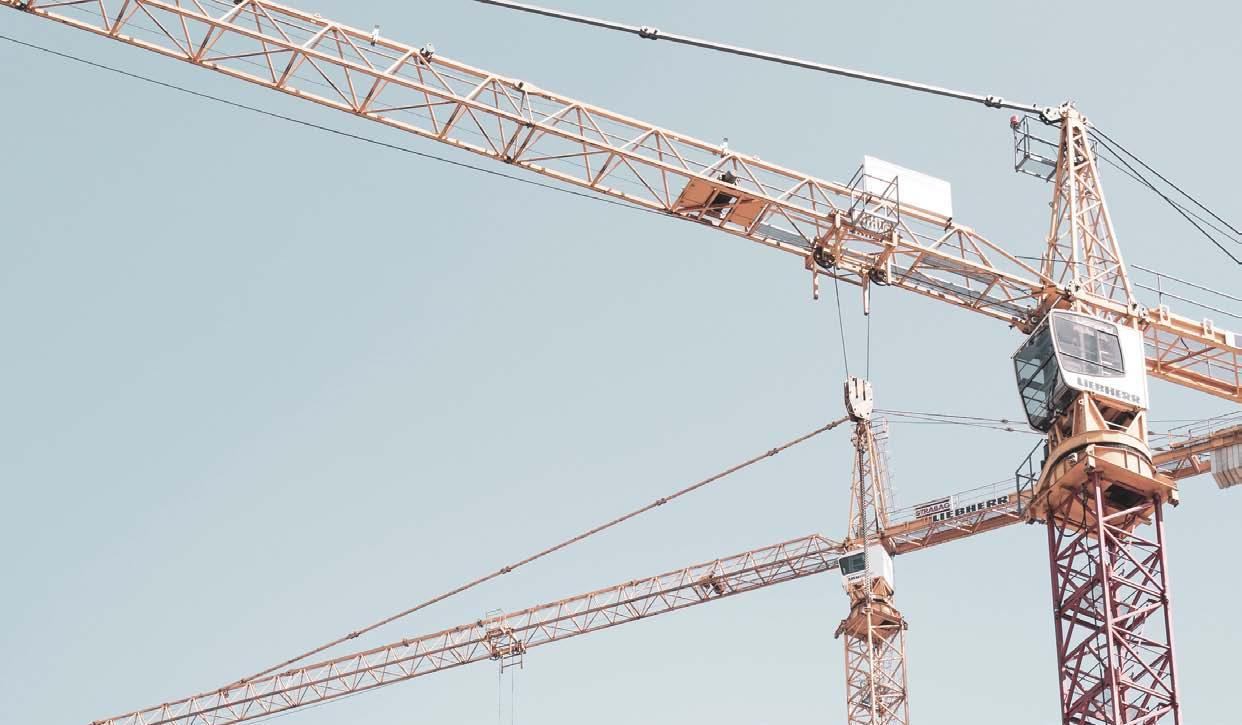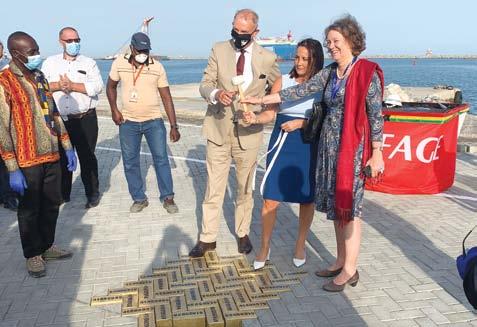
12 minute read
Transport trends
tema Port expansion Project, ghana
Premier infrastructure delivery company AECOM is on track to complete its work on the Tema Port Expansion Project in Ghana, on behalf of Meridian Port Services Ltd. (MPS), in September 2021.
Advertisement
“It has been a very successful project for all stakeholders, especially the client. the project team has managed to deliver the port facilities ahead of the programme, within budget and with a great safety record,” comments Craig thackray, aECoM MEa ports & Marine director.
hEAVy-DuTy PAVINg AND uNDERgROuND uTIlITIES
“We are now operationalising the fourth berth and have just completed supervising the marine works for our client,” reports david Simpson, aECoM Senior resident Engineer, who has been involved with the project since its inception in 2016. this mainly involves heavy-duty paving and underground utilities. the ship-to-shore (StS) crane infrastructure is already in place and the port is fully operational at present. “MpS is an incredibly supportive and focused client. all those working on the project had a common goal and knew this was not going to be a straightforward project to deliver, but by working together, the team delivered this major infrastructure project,” highlights thackray. located about 30 km from the capital city accra, the port of tema accounts for 70% of ghana’s containerised volume. the containerised volume represents less than half of the port tonnage which includes general cargo, bagged commodities, dry and liquid bulk cargo. the container terminal (terminal 2) has been operated by MpS since 2007. building on its success in operating terminal 2, MpS and ghana ports and harbours authority (gpha) extended the concession to include the tema port Expansion project. the tema port Expansion project (terminal 3) is adjacent to the existing tema port and has been designed to provide enough draft and modern container-handling equipment to accept and service the largest container vessels operating on global trade routes. It can accommodate vessels with a capacity of 22 000 tEus, a marked increase from the 5 000 tEus at terminal 2. the new terminal will significantly increase ghana’s container-handling capacity to around 3.7 million tEus a year from 800 000 tEus at terminal 1 & 2. a hallmark of this massive project has been how smoothly it has run from start to finish. “this is a complex mega project in West africa with a very compressed timeline, so it has been quite an achievement for everyone involved to have delivered as much as we have,” highlights Simpson.
An official ceremony to mark the completion of the heavy duty paving
“For us, the Covid-19 pandemic did not create significant disruption as most of the staff required to deliver the project were already on-site. additionally, from a procurement perspective, the bulk of the logistics and materials were largely in place or on site,” adds thackray. Much of this preparedness was due to the excellent working relationship established with MpS. all construction packages were completed on or ahead of schedule and in line with MpS’s operational needs. the
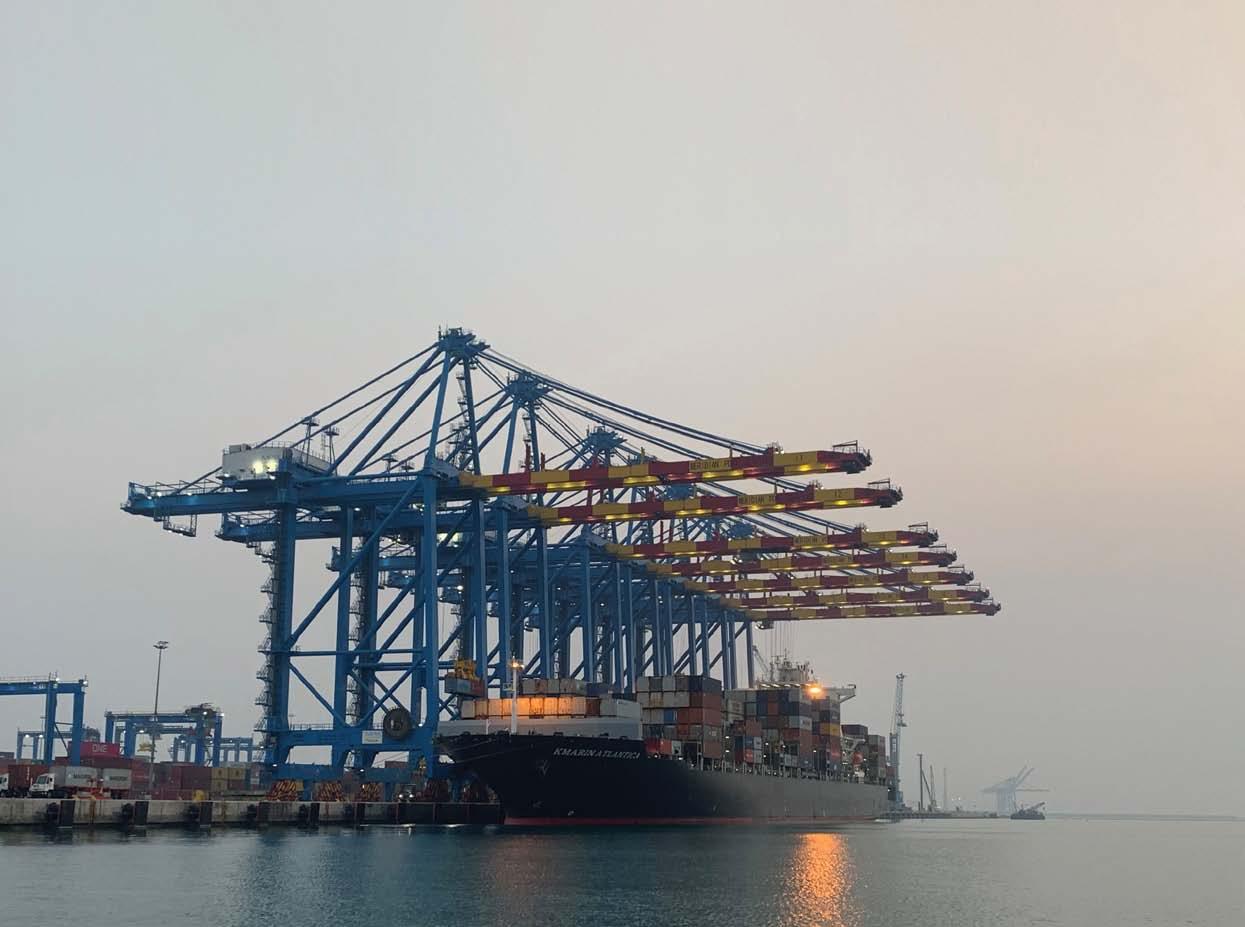
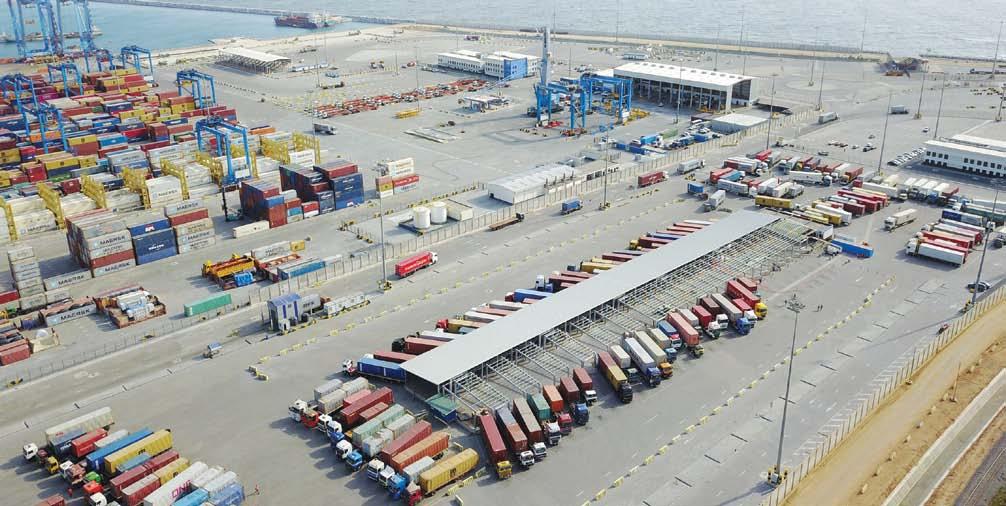
AECOM is on track to conplete its scope of work at Tema Port in September
marine works commenced in late 2016 and the land works in early 2018. the first parts of the quay and rear crane rail were completed in december 2018, allowing for the StS cranes to be commissioned.
fORMIDABlE INTERNATIONAl lOgISTICS
an initial challenge was mobilising international contractors to West africa that had successfully undertaken work there before. the logistical challenge alone was formidable, with aECoM growing from a single employee in ghana at the outset to 85 at the peak of the project. as ghana is a seismically active zone, special attention had to be paid to the design of the marine and land infrastructure. this needed to address liquification of marine sediments and the reclamation materials and the structural stability of the breakwater, quay wall and buildings. Solutions included the removal of liquefaction-prone materials, consolidation of marginal foundation materials and detailed analysis and structural design of major elements.
CONSTRuCTINg ThE BREAKWATER
to support the construction schedule, certain aspects were altered. the quay wall was originally conceived as a conventional gravity blockwork wall, but after detailed planning was undertaken, it was found that the required number of blocks to be placed would delay the schedule. to address this, it was decided to design and construct the quay wall using 2 700 tonne caissons, which played a major role in keeping the marine works on schedule.
For several months, ghana experiences unsuitable sea conditions for marine construction. In order to place the caissons safely and carry out the hard-rock dredging, the advance of the breakwater was carefully planned and constructed. the breakwater provided enough sheltered water for year-round marine operations.
Full-time environmental specialists were provided by aECoM to ensure International Finance Corporation (IFC) compliance. this relates to environmental and social performance standards which define responsibilities for managing environmental and social risks. For example, within the project site there was a turtle hatchery that required careful handling. Environmental management plans and procedures and regular engagement with the local community ensured minimal impact on the surrounding area. the project recorded over 16 million hours with only three lost-time injuries (ltIs). Specific health and safety measures instituted included weekly management safety walks, safety rewards and recognition, integration of the construction and safety teams and limiting the use of divers during works checks when using eco-scopes and bathymetric surveys. the first major milestone was the handover of a portion the project works. this was the first commercial operation for two container berths (700 m), to the operator in June 2019. the second milestone, commercial operations for three container berths (1 000 m), was achieved in april 2020. the marine works for the fourth berth were completed significantly ahead of schedule during June 2020. over 4 000 staff worked on the project, of which over 90% were ghanaians. “having been exposed to international construction standards, health, safety and environmental systems, this project will certainly leave a legacy. the staff returning to the ghanaian labour market have gained skills and training to further develop themselves and contribute to the growth of the economy,” concludes darrin green, aECoM africa Md. n

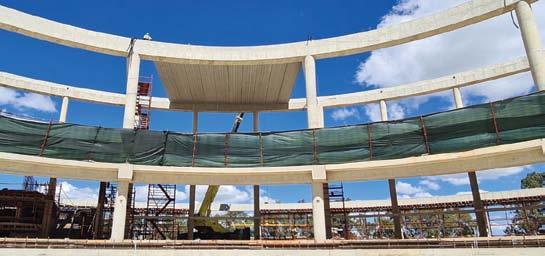
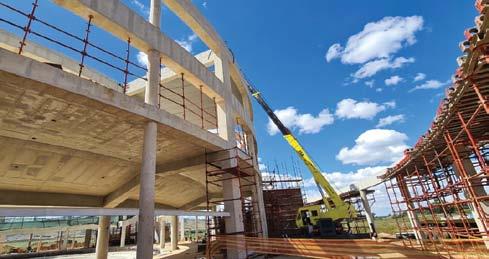
Look to precast to save time and money in the COVID-19 construction environment
Construction timelines in today’s world are usually tight, but there are now even greater pressures arising from delays during the past year’s CovId-19 lockdowns and the generally slower pace of work that has become necessary as businesses, schools and individuals navigate the uncertain waters of everyday life. businesses that can provide efficient, high-quality solutions are finding themselves in an excellent position to help keep construction projects on track in these challenging times. Elematic Sa, which manufactures pre-stressed hollow-core concrete slabs for the South african market, has established a solid reputation for supplying high-quality precast concrete products in tight turnaround times.
Since its establishment in 2005, Elematic Sa (ESa) has been manufacturing high-quality pre-stressed concrete slabs for use in a wide variety of building applications. this is done at its ISo 9001 certified facility on gauteng’s East rand. ESa’s portfolio of projects includes residential, commercial, industrial and other projects around South africa.
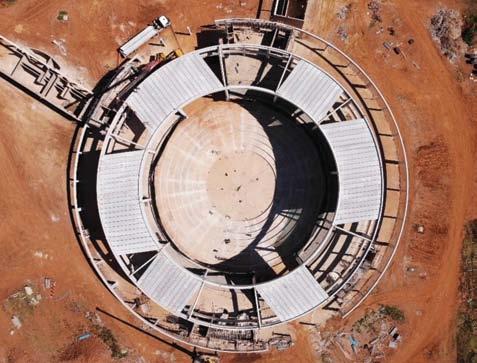
Unity Fellowship Church in Eikenhof under construction
two key factors make ESa’s precast slabs ideal for fast-track construction projects. Firstly, the highly automated fabrication process, carried out in a controlled environment, ensures a consistent level of quality – all of ESa’s products carry the SabS mark of quality. Secondly, much faster construction times can be achieved by using precast products. they eliminate the waiting times associated with cast-in-situ concrete, require no scaffolding, offer longer spans and have a superior depth-tospan ratio. ESa’s highly trained teams will deliver the products to site and install them, freeing up the main contractor to get on with other tasks.
ESa’s slabs were recently used in a rather unusual application for the construction of the roof of the unity Fellowship Church in Eikenhof, south of Johannesburg. vanda Subakov, managing director and lead civil and structural engineer at vitruvius Collective, a multi-disciplinary practice which oversaw the architectural and engineering aspects of the unity Fellowship Church construction, says that whilst the circular structure presented its share of challenges, the support she received from ESa’s inhouse engineers and the careful design process that they went through as a team gave them an excellent result. “using ESa’s slabs saved both time and money, which was one of the reasons we selected them to begin with. We also always experience excellent support from their engineers and team members,” she adds. Construction was completed in a year. providing a top-notch service along with a quality product is one of the cornerstones of ESa’s business, and it is this that has led to repeat work from many of the company’s clients. “We have been specifying ESa’s slabs for over 12 years and they always exceed our expectations,” says Subakov. Craig Webber, managing director of ESa, notes that it is through building lasting relationships based on quality products and service has contributed to keeping business flowing even in the current difficult business environment. n
ABOuT ESA:
Elematic South africa (pty) ltd manufactures precast hollow core concrete slabs for the South african market. Elematic is a wellestablished international brand. the company was established in Finland in 1959 and has since set up precast production plants in more than 70 countries worldwide. as part of a parent group which focuses on research and development in cement and precast concrete products, Elematic is backed by extensive knowledge and experience. Elematic South africa supplies the latest available technology in precast concrete products. Its stateof-the-art production facility on gauteng’s East rand is ISo 9001 certified and all its products carry the SabS mark of quality.
Contact: Craig Webber, Elematic South Africa (Pty) ltd Tel: +27 (0)11 423 2700 Cell: 083 614 9848
the geotechnical challenge of building on dolomite in Gauteng
By Kim Timm, Executive Structures, Buildings and Places Kim Timm (Pr Eng), AECOM
Acommon concern in construction within gauteng is the possibility of building on dolomite. While many structural engineers are aware of the potential hazards of dolomite, not all are aware of the variability of the material or the potential ‘dolomite tax’ you can end up paying within the project to accommodate dolomite considerations on earthworks, foundations, services and occasionally even superstructure.
WhAT lIES BElOW…
From a structural consideration, dolomite needs to be accommodated in the foundation. this can be complicated and requires numerous design iterations to reach an optimum solution. In addition, the ramifications extend far further than just the foundations, and this is frequently forgotten. as there are limitations on locating services within the ground on dolomite sites, the aboveground structure needs to accommodate considerably more complicated services routing and the trenches, sleeves and voids associated with such. all this needs to be designed for in the structure upfront.
For example, we encountered challenging dolomitic ground conditions at the site of the new Exxaro head office in Centurion, pretoria undertaken by growthpoint. here we had to reshape the entire building concept to account for the highly variable ground conditions. We ultimately assessed 16 different variations of the structure with the assistance of the quantity surveyors and the architects to mitigate the underlying foundation risk in the most cost-effective manner possible.

COMBINED SOIl AND CONCRETE RAfT
Instead of piling, we adopted a combined soil and concrete raft approach. the structural foundation system was a 2.25 m reinforced concrete raft, designed to span a 15 m sinkhole. the raft was designed on a mattress of variable spring stiffness, adjusted for the depth to bedrock, the anticipated depth of the Weathered altered dolomite (Wad) and the enhanced soil mattress zone created by dynamic compaction.
What happens below ground has the ability to shape the entire building and project. If this is not considered at the beginning of the project, you are likely to have numerous surprises as you start to excavate, which invariably lead to time delays and cost overruns. It is essential to understand the nature of the ground you are building on so you can appreciate and plan for the problems you might encounter during both excavation and long term on the site.
KEEPINg ThE WATER OuT
If you have a high-water table, the viability of your basement floors could be affected. Certainly, the construction programme, waterproofing requirements and the crack control and jointing on your walls can become more costly. If your soils have a high heave potential, you might need to replace large areas of material or move to a raft foundation or implement water controlling systems or even a combination of all of these.
If you have collapsible soils, you need to understand what can be done short term in terms of wetting and compacting the ground prior to placing foundations, and the potential for long-term localised collapse. When you are building in shales, you need to understand how it can react when exposed to the air and how water can flow through the rock. this strongly affects the construction sequencing and can have time and cost implications if is are not considered as part of the upfront planning. geotechnical investigations should be required on all sites. the extent and detail of the investigation might vary, depending on the nature and size of the planned development. however, even the simplest single-storey structure can be rendered useless within a year by misinterpreting the underlying soils.
We cannot avoid problems under the ground, but clear and detailed geotechnical information is the best way to be able to plan for surprises that might occur. Money spent on geotechnical investigation frequently leads to money being saved during design and construction. good geotechnical information minimises the negative consequences of problematic ground conditions and enables projects to run smoother. n
Kim Timm (Pr Eng), Executive – Structures, Buildings and Places at AECOM
